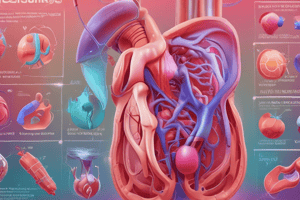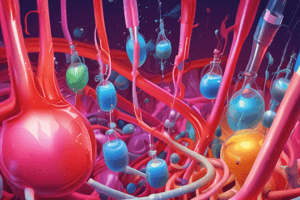Podcast
Questions and Answers
What do pulmonary function tests measure?
What do pulmonary function tests measure?
- Hemoglobin concentration
- Heart function
- Blood oxygen levels
- Lung volume and capacity (correct)
In a chest X-ray (CXR), what does an enlarged heart indicate?
In a chest X-ray (CXR), what does an enlarged heart indicate?
- Normal findings
- Lung infection
- Healthy cardiac function
- Fluid around the heart (correct)
What is the purpose of a sputum culture?
What is the purpose of a sputum culture?
- Measuring blood oxygen levels
- Assessing lung volume
- Visualizing airways
- Identifying respiratory infections (correct)
What is bronchoscopy primarily used for?
What is bronchoscopy primarily used for?
Which diagnostic test involves a thin viewing instrument called a bronchoscope?
Which diagnostic test involves a thin viewing instrument called a bronchoscope?
What is the primary advantage of using an MRI over a CT scan for imaging the body?
What is the primary advantage of using an MRI over a CT scan for imaging the body?
Which of the following is a key limitation of using MRI for medical imaging?
Which of the following is a key limitation of using MRI for medical imaging?
What is the primary function of a D-dimer blood test?
What is the primary function of a D-dimer blood test?
What is the main purpose of performing a thoracentesis procedure?
What is the main purpose of performing a thoracentesis procedure?
Which of the following is a key difference between a CT scan and a standard X-ray?
Which of the following is a key difference between a CT scan and a standard X-ray?
Which of the following procedures directly visualizes the airways and lungs?
Which of the following procedures directly visualizes the airways and lungs?
Which imaging test uses X-rays to produce images of the lungs and surrounding structures?
Which imaging test uses X-rays to produce images of the lungs and surrounding structures?
Which of the following tests uses ionizing radiation to create detailed, cross-sectional images of the lungs and surrounding structures?
Which of the following tests uses ionizing radiation to create detailed, cross-sectional images of the lungs and surrounding structures?
Which imaging test uses strong magnetic fields and radio waves to produce detailed images of the lungs and surrounding structures, without exposing the patient to ionizing radiation?
Which imaging test uses strong magnetic fields and radio waves to produce detailed images of the lungs and surrounding structures, without exposing the patient to ionizing radiation?
Which of the following tests evaluates the heart's response to physical stress and can help detect potential issues with oxygenation and circulation?
Which of the following tests evaluates the heart's response to physical stress and can help detect potential issues with oxygenation and circulation?
How do bronchodilators promote oxygenation in the lungs?
How do bronchodilators promote oxygenation in the lungs?
What is the primary function of expectorants in promoting oxygenation?
What is the primary function of expectorants in promoting oxygenation?
Why is inhalation the preferred route for administering bronchodilators?
Why is inhalation the preferred route for administering bronchodilators?
How does pursed-lip breathing differ from incentive spirometry in aiding oxygenation?
How does pursed-lip breathing differ from incentive spirometry in aiding oxygenation?
How do anti-inflammatories contribute to promoting oxygenation?
How do anti-inflammatories contribute to promoting oxygenation?
Why is it important to exhale normally before using the spirometer?
Why is it important to exhale normally before using the spirometer?
How does a volume-oriented device differ from a flow-oriented device in spirometry?
How does a volume-oriented device differ from a flow-oriented device in spirometry?
Why does a slow inspiration provide greater lung expansion than a brisk, shallow breath during spirometry?
Why does a slow inspiration provide greater lung expansion than a brisk, shallow breath during spirometry?
In spirometry, why should low-volume and brisk breaths be avoided when using a flow-oriented device?
In spirometry, why should low-volume and brisk breaths be avoided when using a flow-oriented device?
How does sustained elevation of balls or cylinders in a spirometer ensure adequate ventilation of the alveoli?
How does sustained elevation of balls or cylinders in a spirometer ensure adequate ventilation of the alveoli?
What is the maximum flow rate administered via a nasal cannula?
What is the maximum flow rate administered via a nasal cannula?
Which of the following is NOT considered a low-flow oxygen administration device?
Which of the following is NOT considered a low-flow oxygen administration device?
What is the purpose of a chest X-ray (CXR) when assessing a patient receiving supplemental oxygen?
What is the purpose of a chest X-ray (CXR) when assessing a patient receiving supplemental oxygen?
Which diagnostic test is most commonly used to assess the patency and anatomy of the airways when a patient is experiencing respiratory distress?
Which diagnostic test is most commonly used to assess the patency and anatomy of the airways when a patient is experiencing respiratory distress?
What do pulmonary function tests typically measure?
What do pulmonary function tests typically measure?
Which of the following is NOT one of the four components of respiration?
Which of the following is NOT one of the four components of respiration?
Which diagnostic test is primarily used to visualize the airways and detect abnormalities such as tumors, inflammation, or bleeding?
Which diagnostic test is primarily used to visualize the airways and detect abnormalities such as tumors, inflammation, or bleeding?
What does an enlarged heart typically indicate on a chest X-ray (CXR)?
What does an enlarged heart typically indicate on a chest X-ray (CXR)?
Which pulmonary function test measures the amount of air a person can forcibly exhale in one second?
Which pulmonary function test measures the amount of air a person can forcibly exhale in one second?
Which imaging modality is most effective for detecting and evaluating lung nodules or masses?
Which imaging modality is most effective for detecting and evaluating lung nodules or masses?
Which pulmonary function test measures the total volume of air a person can inhale after a maximum exhalation?
Which pulmonary function test measures the total volume of air a person can inhale after a maximum exhalation?
What is the primary purpose of a sputum culture?
What is the primary purpose of a sputum culture?
Which imaging modality is most effective for evaluating the structure and function of the heart and great vessels?
Which imaging modality is most effective for evaluating the structure and function of the heart and great vessels?
What is the primary purpose of a pulmonary function test?
What is the primary purpose of a pulmonary function test?
Which diagnostic test involves the insertion of a thin, flexible viewing instrument called a bronchoscope into the airways?
Which diagnostic test involves the insertion of a thin, flexible viewing instrument called a bronchoscope into the airways?
Flashcards are hidden until you start studying
Study Notes
Impaired Oxygenation
- Caused by lower than normal number of red blood cells, reduced hemoglobin, or abnormal hemoglobin function
- Hypoventilation can occur due to slow or shallow breathing, diseases of respiratory muscles, drugs, or anesthesia
- Hyperventilation involves increasing breaths through a ventilator or manual resuscitation bag
Diagnostic Studies for Respiratory Function
- Sputum and throat culture specimens
- Blood tests: arterial blood gases
- Pulmonary function tests
- Visualization procedures: x-rays, lung scans, laryngoscopy, bronchoscopy
- Pulmonary function tests measure lung volume and capacity
- Chest X-Ray (CXR) reveals an enlarged heart
- Bronchoscopy allows a physician to visualize airways through a bronchoscope
- Computerized Tomography (CT) scan produces a three-dimensional image of the organ or structure
- Magnetic Resonance Imaging (MRI) is a non-invasive diagnostic scanning technique that distinguishes minor differences in tissue density
- Ventilation/Perfusion Scan
- D-Dimer Test measures D-dimer protein fragment in the blood
- Thoracentesis removes excess fluid or air from the pleural cavity to ease breathing
Arterial Blood Gases (ABGs)
- Evaluate a client's acid-base balance and oxygenation
- Arterial blood is used because it provides a more accurate reflection of gas exchange in the pulmonary system than venous blood
- Blood gases may be drawn by laboratory technicians, respiratory therapy personnel, or nurses with specialized skills
- Apply pressure to the puncture site for at least 5 minutes after the procedure to reduce the risk of bleeding or bruising
Electrocardiogram (ECG)
- Provides a graphic recording of the heart's electrical activity
- Electrodes placed on the skin transmit electrical impulses to an oscilloscope or graphic recorder
Echocardiogram
- Non-invasive test that uses ultrasound to visualize heart structures and evaluate left ventricular function
- Images produced as ultrasound waves are reflected back to a transducer after striking cardiac structures
Stress Test
- Assesses cardiovascular function during physical activity
Assessment Signs and Symptoms of Impaired Oxygenation
- Adventitious Breath Sounds:
- Crackles: air passing through fluid or mucus in any air passage
- Gurgles: air passing through narrowed air passages as a result of secretions, swelling, tumors
- Friction rub: rubbing together of inflamed pleural surfaces
- Wheeze: air passing through a constricted bronchus as a result of secretions, swelling, tumors
Interventions to Promote Oxygenation
- Medications:
- Bronchodilators: reduce bronchospasm, opening tight or congested airways and facilitating ventilation
- Anti-inflammatories: decrease edema and inflammation in airways, allowing better air exchange
- Expectorants: help "break up" mucus, making it more liquid and easier to expectorate
Techniques to Promote Oxygenation
- Pursed-lip breathing: breathe in normally through the nose and exhale through pursed lips as if about to whistle, tightening abdominal muscles to assist with exhalation
- Incentive spirometry: teaches clients to take slow, deep breaths, holding breath for 2-6 seconds to elevate balls or cylinder, maintaining lung expansion and preventing atelectasis
Studying That Suits You
Use AI to generate personalized quizzes and flashcards to suit your learning preferences.




